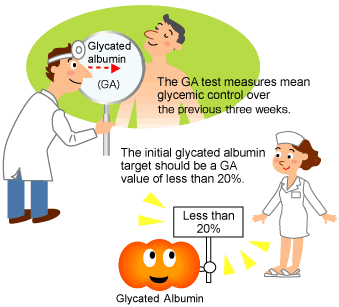AsahiKASEI Glycated Albumin reagent
Outline of the Glycated Albumin (GA)
Diabetes afflicts an increasing number of people worldwide each year.Proper blood glucose control is essential in preventing complications associated with diabetes, such as neuropathy, nephropathy, and retinopathy.
Glycated albumin (GA) is one marker used to ascertain glycermic control. GA reflects mean glycemia over the three weeks prior to blood sampling.
Asahi Kasei Lucica GA-L liquid reagnets measure GA using conventional automated analyzers, permitting rapid and accurate results across a range of clinical setting.
What is glycated albumin (GA) ?
Glycation is the bonding of a sugar molecule, such as glucose, to a lipid or protein molecule, such as albumin. Thus, glycated albumin refers to albumin to which glucose has bonded.
Albumin is present not only in blood, but also in major organs and body fluids. Albumin serves to maintain cell shape and plays an important function in the distribution of hormones, nutrients and some drugs in the body.

The amount of glycated albumin decreases when blood glucose levels are low and increase when blood glucose levels are high.
When is the Glycated Albumin measured ?
Glycated albumin is measured when diabetes therapy is intiated to determine medication regimens and doses and to assess overall therapy efficacy.

The following disorders can markedly alter albumin and hemoglobin life spans, potentially affecting measurement values.
Glycated albumin............nephrosis, cirrhosis, and thyroid functional disorder.
Glycated hemoglobin........anemia, renal failure, and cirrhosis.
Distingushing between Glycated Hemoglobin and Glycated Albumin
Changes in glycated albumin and glycated hemoglobin values after the initiation of treatment were investigated. After the strat of the trearment, glycated albumin measurements showed improved values within approximately one week.

Glycated albumin is measured at the onset of therapy, and then every two four weeks thereafter to adjust medication regimens. Glycated albumin provides a more reapid indication of treatment efficacy or disease state deterioration, than glycated hemoglobin.
Glycated hemoglobin is measured at initial assessment when no prior data on glycemic control are available, and then every one to two months once stable glycemic control has been achieved, to assess average blood glucose over an extended period of time.
Tests in Diabetes
Since diabetes has no subjective symptoms, clinical testing is essential for detection and treatment of the disease.
Various clinical tests are employed in the treatment of diabetes. The following tests are represnetative examples.
|
Confirming Diabetes Treatment Efficacy
Because glycated albumin rapidly and markdly reflects changes in mean blood glucose, the measurement of glycated albumin is well suited for assessing treatment regimines as well as evaluating treatment efficacy.
When an effective treatment regimen has been applied, improvement in the glycated albumin value can generally be observed in about one week.
Clinical Tests for Confirming the Efficacy of Diabetes Treatment
| Blood Glucose Test | Directly measures blood glucose at a single point in time The blood glucose test measures the amount of blood glucose at the time the blood sample is drawn. Blood glucose fluctuates depending on food intake, level of physical activity, and physical condition. |
| Glycated Albumin (GA) Test | Provides an index by which treatment efficacy can be evaluated and treatment regimens assessed The GA test measures mean glycemic control over the previous three weeks. |
| Glycated Hemoglobin (HbA1c) Test | Assesses average glycemia over an extended time period The HbA1c test measures mean glycemic control over the previous two months. Short-or medium-term changes in average blood glucose cannot be suitably assessed with the HbA1c test. |

The initial glycated albumin target should be a GA value of less than 20%.
The standard range for glycated albumin is 11% to 16%.


